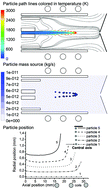Particle transport through an inductively coupled plasma torch: elemental droplet evaporation
Abstract
We studied the transport of copper droplets through an inductively coupled plasma, connected to the sampling cone of a mass spectrometer, by means of a computational model. The sample droplets are followed until they become evaporated. They are inserted as liquid particles from the central inlet and the effects of injection position (i.e. “on” and “off” axis), droplet diameter, as well as mass loading flow rate are investigated. It is shown that more “on-axis” injection of the droplets leads to a more straight path line, so that the droplets move less in the radial direction and are evaporated more on the central axis, enabling a better sample transfer efficiency to the sampler cone. Furthermore, there are optimum ranges of diameters and flow rates, which guarantee the proper position of evaporation along the torch, i.e. not too early, so that the sample can get lost in the torch, and not too late, which reduces the chance of becoming ionized before reaching the sampler.

- This article is part of the themed collections: JAAS Recent HOT articles and 2015 European Winter Conference on Plasma Spectrochemistry, Munster, Germany

 Please wait while we load your content...
Please wait while we load your content...